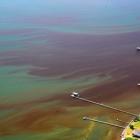In August 2014, toxic algae blooms in Lake Erie affected the water supply in Toledo, OH, leading to a ban on using tap water due to dangerously high levels of the toxin microcystin. Even though the public discourse in the former manufacturing hub centered on hanging tough and the virtues of self-reliance, half a million people lost their water supply for three days, and many continued to rely on bottled water for months afterwards. Lake Erie has one of the largest freshwater dead zones in the world. Its primary source of “nutrient pollution,” a bureaucratic euphemism with intriguing existential connotations, has been identified as the excess fertilizer washing into the lake through the Maumee River, which runs through heavily farmed areas of Indiana.

Toxic algae blooms.
Toxic algae blooms.
Click here to view CDC source.
 This work is licensed under a Creative Commons Public Domain Mark 1.0 License.
This work is licensed under a Creative Commons Public Domain Mark 1.0 License.
While the harmful impact of pesticides on the natural environment and particularly on insect life is now well known, excessive fertilizer use can be no less deadly. Toxic algae blooms and dead zones are the product of the paradoxical linking of eutrophication and anoxia. Excess fertilizer from fields and residential lawns washes into streams and rivers and eventually reaches the ocean. In all of these water bodies, it promotes the growth of algae, including toxic varieties.
The presence of large amounts of nutrients like phosphorous and nitrogen in the water leads to an excess of life on the surface, or eutrophication. The decomposition of the algae blooms produces bacteria that use up all the oxygen in the water, creating anoxic or dead zones, where no plant or animal life can flourish. Some types of algae blooms are toxic, and cause serious harm to humans and animals as well as marine life. Fish or seafood from waters affected by toxic algae blooms can be poisonous.
The Toledo crisis was not an isolated incident. In September 2015, an “unprecedented” patch of toxic algae covered a 500-mile stretch of the Ohio River, from West Virginia to Louisville, Kentucky. There are over 400 dead zones now in existence, mainly in coastal waters and inland lakes, concentrated in the Gulf of Mexico, the northwest US pacific coast, Western Europe, and parts of Southeast Asia.
Not all dead zones are due to human activity, but their increasing numbers and extent, recorded by oceanographers since the 1970s, are. Fertilizer runoff from agriculture and lawns is the biggest contributor to eutrophication, followed by discharge from wastewater treatment and industrial plants, and pollution from animal waste originating in large-scale livestock farms. The use of fossil fuels releases nitrogen oxides into the atmosphere, whereby excess nitrogen enters the water cycle. Warming water temperatures also contribute to the growth of algae blooms.
Dead zones can and have been brought back to life, largely as a result of reductions in fertilizer runoff. This can be achieved through farming practices like creating grass buffer zones around fields, especially where they border streams and other bodies of water; planting cover crops; no-till techniques; and minimizing the use of manufactured fertilizers. All of these reduce runoff. Other solutions include the introduction of shellfish like mussels which filter water, the use of fertilizers that don’t contain nitrogen and phosphorous, and limiting the use of fossil fuels.
The problem, of course, is that there is no clear political path to implementing these. A case in point is the Waters of the United States rule issued by the EPA in March 2015, to clarify which waters are protected by the Clean Water Act of 1972. This rule protects streams and waterways that impact the health of waters downstream. This was a first step in limiting “non-point” sources of water pollution such as fertilizer runoff.
Opposition to the rule united a large number of groups including the Chamber of Commerce, the National Association of Manufacturers, the American Farm Bureau Federation, Dairy Farmers of America, as well as pesticide manufacturers, food and beverage manufacturers, energy and mining companies, state and local governments, water utilities, the timber industry, railroads, real estate developers and golf course operators. In October 2015, a federal appeals court in Cincinnati blocked the application of the rule nationwide.

Map of dead zones around the world. Created by Dr. Robert Diaz of the Virginia Institute of Marine Science (VIMS).
Map of dead zones around the world. Created by Dr. Robert Diaz of the Virginia Institute of Marine Science (VIMS).
Source: http://disc.sci.gsfc.nasa.gov/education-and-outreach/additional/science-…
 This work is licensed under a Creative Commons Public Domain Mark 1.0 License.
This work is licensed under a Creative Commons Public Domain Mark 1.0 License.
Two types of arguments are offered against extending the 1972 Clean Waters Act. First, that the extension is an encroachment by the federal government on states’ and individual owners’ rights. This was the basis for the stay ordered by the federal appeals court. And secondly, that implementing any reductions in nutrient pollution would increase the cost of doing business and raise food prices. This dominant narrative views the problem in terms of trade-offs, such as cheaper food versus clean water. Environmentalists might point out that not all costs can be monetized, and long lasting damage to the environment may in itself be an unacceptable cost. New forms of advocacy and developing jurisprudence, based on notions of the Rights of Nature, may define large-scale pollution as the crime of ecocide.
The Toledo water crisis prompted Ohio to pass a new law in 2015, which governs the amount and manner of fertilizer use on farms. While this is a step forward, it cannot address the sources of pollution upriver in other states.
How to cite
Mathur, Shubh. “Dead Zones and Toxic Algae Bloom in US Waters.” Environment & Society Portal, Arcadia (Spring 2017), no. 7. Rachel Carson Center for Environment and Society. https://doi.org/10.5282/rcc/7748).
ISSN 2199-3408
Environment & Society Portal, Arcadia
 This work is licensed under a Creative Commons Attribution 4.0 International License.
This work is licensed under a Creative Commons Attribution 4.0 International License.
2017 Shubh Mathur
This refers only to the text and does not include any image rights.
Please click on an image to view its individual rights status.
- Centers for Disease Control and Prevention (CDC). "Harmful Algal Bloom (HAB)-Associated Illness." Accessed 14 February 2017. https://www.cdc.gov/habs/index.html
- Diaz, R. J., and R. Rosenberg. "Spreading Dead Zones and Consequences for Marine Ecosystems." Science 321, no. 5891 (2008): 926-9. Last accessed 20 June 2016. doi: 10.1126/science.1156401
- Environmental Protection Agency (EPA). "Clean Water Rule Protects Streams and Wetlands Critical to Public Health, Communities, and Economy." Press release: 27 May 2015. Last accessed 20 June 2016. https://www.epa.gov/newsreleases/clean-water-rule-protects-streams-and-wetlands-critical-public-health-communities-and
- Hopkinson, Jenny. "Obama's Water War." Politico 27 May 2015. Last accessed 30 January 2017 http://www.politico.com/story/2015/05/epa-waterways-wetlands-rule-118319
- Kozacek, Codi. "World Stands By As Algae and Dead Zones Ruin Water." Circle of Blue 25 September 2014. Last accessed 20 June 2016. http://www.circleofblue.org/waternews/2014/world/draft-world-stands-algae-dead-zones-ruin-water/
- Mee, Lawrence. "Reviving dead zones." Scientific American November 2006. Last accessed 20 June 2016. http://faculty.bennington.edu/~sherman/the%20ocean%20project/reviving%20dead%20zones.pdf
- Wines, Michael. "Behind Toledo’s Water Crisis, a Long-Troubled Lake Erie." New York Times 4 August 2014. Last accessed 20 June 2016. http://www.nytimes.com/2014/08/05/us/lifting-ban-toledo-says-its-water-is-safe-to-drink-again.html








